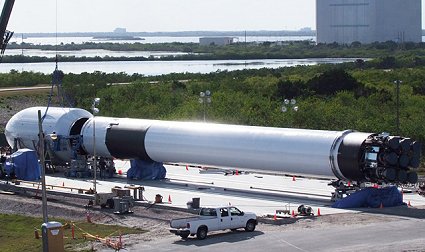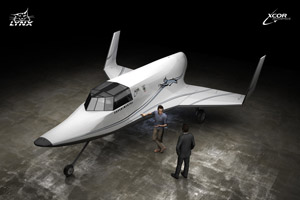 |
| HobbySpace Home |
NewSpace NewSpace Glossary RLV & Space Transport Resources |
|
Climbing a Commercial Stairway to Space: |
||||||||||||||||||
|
||||||||||||||||||
|
As with the previous Commercial Stairway to Space Timelines for 2008, 2007, 2006, 2005, and 2003, I will lay out here what I considered a realistic set of milestones that would lead to a scenario in which private, commercial activity dominates human spaceflight** activity by 2015 or so. In Table 1 below I provide a detailed comparison of what happened in 2008 versus my expectations in January 2008. Then Table 2 presents my current expectations for developments in commercial spaceflight through 2020. I begin first with a general discussion of the state of commercial spaceflight and where I think it is going. 2008 was a Good Year As in previous years, some predictions for 2008 came true and others did not. In my latest annual review - NewSpace in 2008: Ups and Downs in entrepreneurial spaceflight - I presented lots of evidence that the private NewSpace entrepreneurial space industry made significant progress up the commercial space stairway in 2008. Particular highlights included the first successful launch of the SpaceX Falcon 1 rocket, the winning of the Northrop Grumman Lunar Lander Challenge Level I competition by Armadillo Aerospace, roll-out of the White Knight Two, and the first public exhibition flights of the XCOR's rocket racer. Some of the organizations that were highlighted in previous years, such as Bigelow Aerospace and Blue Origin, were relatively quiet in 2008. This does not mean they became inactive. Quite the contrary. They simply are staying out of the media spotlight while concentrating on hardware development. In 2008 we again did not see any commercial rocket transports carrying people reach space. As discussed last year, for various reasons the quick development of suborbital space tourism expected after the X PRIZE success by SpaceShipOne in October of 2004 has not happened. However, in 2008 there was considerable progress by several companies in this area. Needed: Good Execution and a Bit of Luck 2015 is just six years away. Is it really possible that private, commercial organizations could dominates human spaceflight activity by then? Yes, but we need for everybody to execute successfully both in vehicle development and business plans. Plus we need some luck with hardware development, flight successes, the overall economy, etc. I would consider the following scenario to be a minimal threshold definition for "domination" of spaceflight activity by commercial firms by 2015:
In such a scenario, we would have by 2015 several hundred people flying to 100km per year on private suborbital space transports and several dozen to orbit per year on Falcon 9. That would dwarf the number of people flying annually on government vehicles to space. Parts 1 and 4 of the scenario look quite solid. There are several suborbital vehicles in development and they are making solid progress. Test flights will start late this year for some of the firms and all will be test flying in 2010 There could easily be three or four fully reusable, fast turnaround vehicles flying with paying passengers to 100 km routinely by 2011. Bigelow Aerospace has proven with the two Genesis spacecraft that it is quite capable of building sophisticated hardware and carrying out complex launch and orbital operations. So placing Sundancer and Nautilus habitats successfully in orbit has a high probability of success. Parts 2 and 3 are the tricky ones. Successful execution of F9/Dragon development project would provide the first real step towards lower cost human spaceflight since the 1960s. It will be great if other firms, such as the suborbital guys, come forth with orbital systems on this time scale. The above scenario is just a straightforward extrapolation of what is happening at the moment. It's quite possible other players will become involved. Falcon 9/Dragon - The Key At the moment development of the Falcon 9/Dragon looks very promising. Many common components have been tested in flight on the Falcon I. The Merlin engine, in particular, performed well on flights 2-4. The Merlin has also been tested extensively in ground tests and the 9-engine full flight duration test went well. SpaceX is meeting its COTS milestones for the F9/Dragon. This includes the passing of several design reviews by outside experts. The assembly and raising to vertical of a F9 on the pad at Cape Canaveral in late 2008 was impressive. On the other hand, no one should be shocked if there is one or more failures or partial failures (e.g. the payload does not reach the correct orbit) with the first Falcon 9 vehicles. The failures of the launches of the first three Falcon I vehicles attest to the difficulties of moving a totally new vehicle into operation. Rockets are complex conglomerations of a large number of subsystems and many of these subsystems can cause the whole vehicle to fail if they have a problem. Furthermore, with the Falcon 9 type of architecture, a launch is either a success or a failure; there is no gradual expansion of the performance envelope with test flights. We can hope that the Falcon I has successfully served its role as pathfinder for the company's larger vehicle, which was always the primary goal. The company started in late 2002 with zero employees and developed the Falcon I with no legacy hardware and with no major aerospace partner. The company has learned lots of lessons from the Falcon I program and this should help in at least shortening the Falcon 9 learning curve. Dark Financial Clouds In the first Timeline that I create in late 2002, I offered a list of potential roadblocks to commercial spaceflight development. The first in the list was the following:
So far, the current steep economic downturn has not significantly impacted the major NewSpace projects, at least from what is visible publicly. However, if the recession gets deeper and lasts longer than expected, then all the NewSpace projects will be affected negatively to various degrees. Funding may decrease and the markets that they plan to serve will shrink. We can hope that by the time these projects open up for business in 2010-2011, economic growth will have resumed and that funding and markets will become robust. This Prediction Stuff The timeline exercise here is partly for fun. The future has an annoying tendency to unfold in ways we do not expect. So any specific predictions must be taken with a grain of salt. However, these timelines can serve as a useful measuring stick for progress towards the ultimate goal of large scale commercial human spaceflight. I should point out that I deal almost entirely with predictions for successful developments. It is trivial to predict that this or that space project will fail. There are a million ways for a new business of any kind to go off the road, and even more for a new space business. There are only a few routes to success and they are difficult to follow. Predicting losers in the commercial space race is no more fun or informative than predicting horses to lose at the racetrack. I'm much more interested in the details of how and why space projects succeed or fail. Many people seem to think there is some sort of profound physics or economic barrier to low cost spaceflight. However, so far, those ventures that have failed have done so because of mundane reasons usually involving a failure to raise enough capital. Another aspect of technological prediction that I've noticed over my lifetime is that by the time a major advance is achieved, it is often taken for granted and not considered a big deal. This can happen because the developments occurred incrementally over a long time period. For example, the nearly instantaneous Google search of an gigantic database of information gathered continually worldwide would have seemed a sci-fi miracle in 1990. However, it is considered no big deal today after the public has experienced 15 years or so of steady Internet advances. I've seen a similar response to commercial space developments. For example, space tourism has gone from a wild fantasy in 1999 to a situation today in which "personal spaceflight participants" are going yearly to the ISS and several hundred million dollars of investment has been committed to suborbital space tourism ventures. Similarly, steady incremental advances towards commercial human spaceflight have transformed it from a fantasy to a near certainty. A private company has two prototype inflatable habitats in orbit and NASA just contracted for commercial cargo delivery service to the ISS. At the rate that things are going, I wouldn't be at all surprised to find that by 2020 it will be considered routine for most space travelers to get to orbit on commercial vehicles. |
||||||||||||||||||
|
Timelines - Old and New
|
||||||||||||||||||
|
The first table focuses on the specifics in the predicted 2008 timeline versus what actually happened. The second table lays out a revised timeline starting from 2009. As always, since lowering the cost of transport from earth to orbit is crucial to all the important goals in space, that category is given the greatest emphasis here. See the 2004 discussion of factors that could delay or accelerate the scenario laid out here. |
||||||||||||||||||
|
||||||||||||||||||
|
|
||||||||||||||||||
** Note: I often use just the word spaceflight as shorthand for human spaceflight. So with commercial spaceflight I'm referring to space tourism (both orbital and suborbital), Bigelow habitats, and other human related space activities involving private companies and organizations while with the term commercial space I'm adding in all the other commercial activity like communication satellites, remote sensing, GPS, etc. |
||||||||||||||||||

|
||||||||||||||||||
|
Support |
| Affliate Programs |
| Amazon.com & Amazon.co.uk - space books, GPS, satellite dishes, and more |
| HobbySpace Home | Space Log | Science & Technology |


